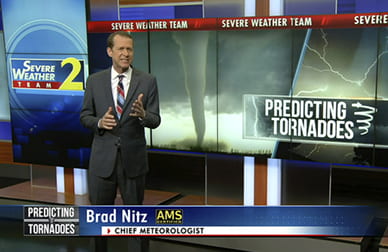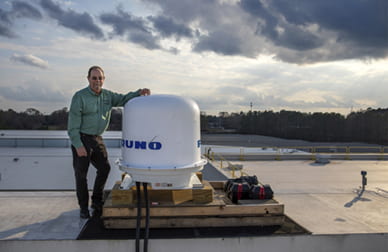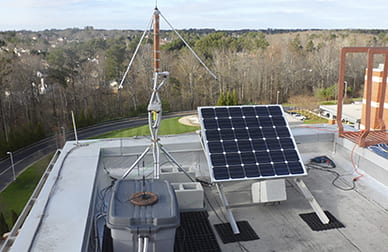
The Severe Storms Research Center (SSRC) was established in 1999 at the Georgia Tech Research Institute (GTRI) after a task force formed by Georgia’s governor recommended creating an organization to coordinate the state’s severe weather forecasting, with funding from the Georgia Emergency Management Agency (GEMA), the Federal Emergency Management Agency (FEMA), and the State of Georgia. SSRC is a focal point for severe storm research in Georgia.
The SSRC is actively engaged in developing alternative methods of detecting and forecasting severe local storms and exploring improvements to existing storm prediction and sensor technology.
GTRI researchers have an array of specialized systems measuring conventional meteorological parameters (temperature, humidity, pressure, wind, etc.), three dimensional lightning data, atmospheric electric fields and sferics, infrasound, and lightning channel detection. For example, the SSRC operates the North Georgia Lightning Mapping Array (NGLMA), a network of lightning detection sensors centered on Atlanta. This network collects three dimensional, real-time “source” data of intracloud and cloud-to-ground lightning. The data allows SSRC researchers to study trends in lightning data in north Georgia to better understand severe weather. This data is shared in real time with the local National Weather Service office.
The live web site of NGLMA data can be accessed here.
The SSRC research team collaborates with other meteorologists in the operational and research communities. This includes the National Weather Service and faculty from the Georgia Tech School of Earth and Atmospheric Sciences, including providing real-world research opportunities for the school’s students.

- Brad Nitz spoke with researchers at The Georgia Tech Research Institute about a project that could help predict a tornado before it happens.

- A weather radar system purchased by the Georgia Institute of Technology and the University of Georgia could lead to improved weather forecasting in North Georgia.

- Researchers at the Severe Storms Research Center (SSRC) at Georgia Tech completed their first tornado season since installing three state-of-the-art Warning Decision Support Systems (WDSS) in metro Atlanta early this year.

- Georgia ranks high among tornado-plagued areas of the United States. It was 18th among the most affected states between 1953 and 2004. And in 2007, Georgia experienced 42 twisters; only seven states suffered more hits.

- Learn about the instruments used and the research being done at the Severe Storms Research Center at Georgia Tech.

- The Severe Storms Research Center (SSRC) has developed, deployed, and is operating the North Georgia Lightning Mapping Array (NGLMA).